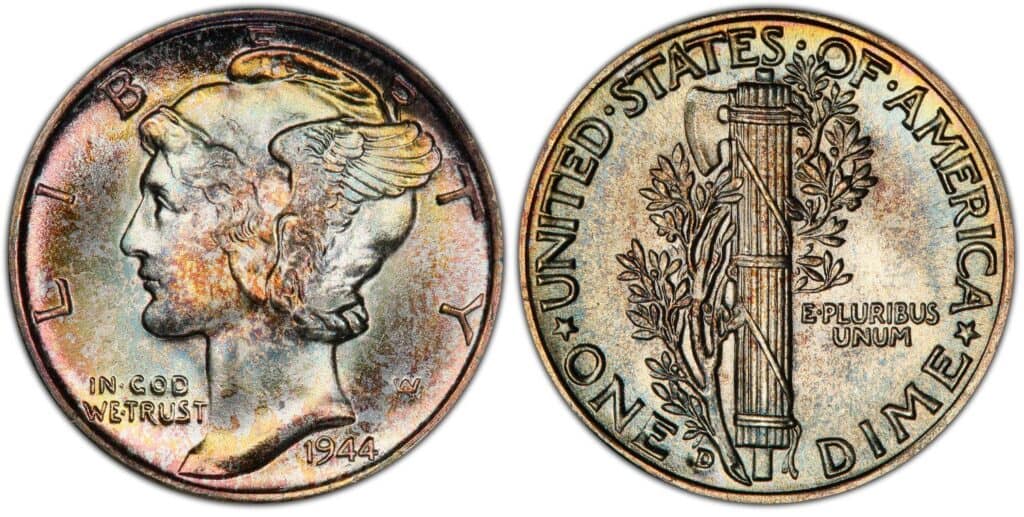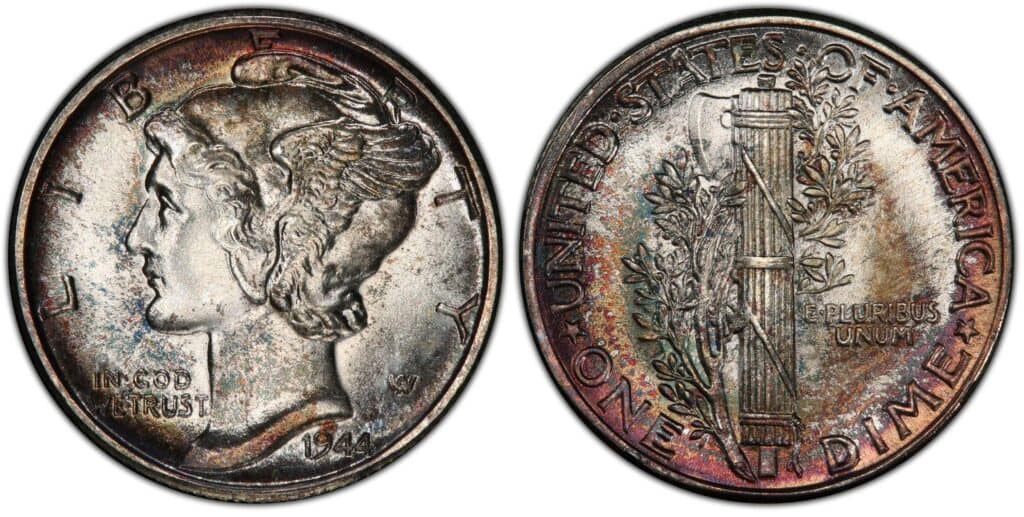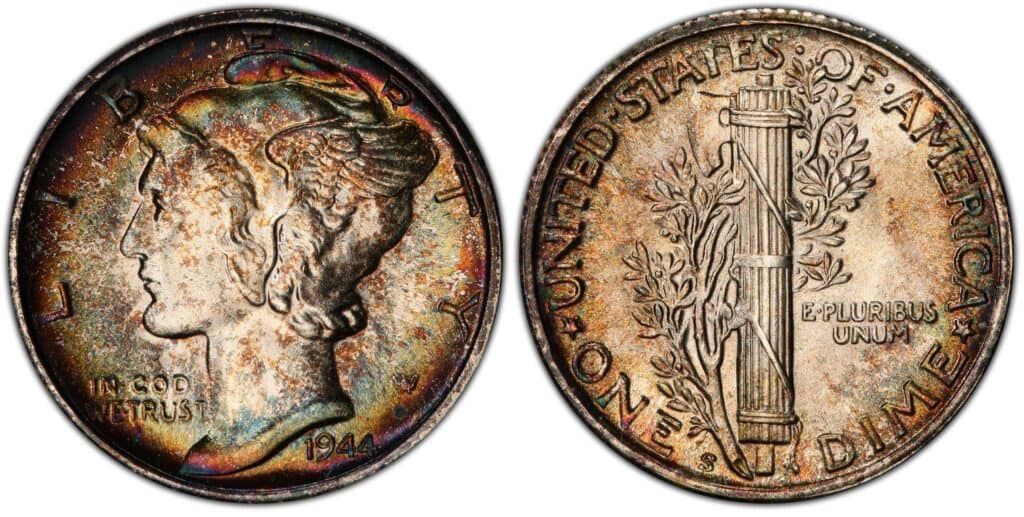What Is the 1944 Mercury Dime Made Of?
The US Mint produces a variety of coins, but the Mercury Dime was undoubtedly one of the more well-known ones throughout the first part of the 20th century. Though the US Mint no longer produces Mercury Dimes, they are still treasured as collector’s items.
We will review the 1944 Mercury Dime’s composition, design, price value, historical turning points, and other essential information. You’ve come to the right place if you’re looking for further details.
The Mercury dime, often known as the Winged Liberty Head dime, is composed of 0.900 silver (90%) and 0.100 copper (10%). When you examine the coin, it has a reeded edge with 118 reeds—a diameter of 17.91 millimeters or 0.705 inches and a weight of 2.50 grams.

From late 1916 to 1945, the United States Mint produced the Mercury dime, a ten-cent denomination. The Winged Liberty Head dime, designed by Adolph Weinman, got its common name because the obverse depiction of a young Liberty, identifiable by her winged Phrygian cap, was mistaken for the Roman god Mercury.
Elsie Stevens, the wife of lawyer and poet Wallace Stevens, is thought to have served as a model for Weinman. The coin’s reverse features fasces, unity, strength, and an olive branch, which means peace.
After 25 years of production, the dime, quarter, and half dollar created by Mint Chief Engraver Charles E. Barber may be replaced by the treasury, a division of the mint, without Congressional approval in 1916.
The wrong idea that the designs needed to be updated led the mint administrators to hold a competition between three sculptors, in which Barber, who had been in his position for 36 years, also participated. The dime and half-dollar designs by Weinman were chosen.
1944 Mercury Dime Varieties
October 30, 1916, was when the Mercury dime started circulating in the United States, the same time the barber dime ceased circulation. At the time of its production, the Denver mint produced the least quantity. The low production is due to a great demand for quarters which prompted von Engelken to inform three mint superintendents to focus on making quarters until it is filled.
All mints in Denver, San Francisco, and Philadelphia produced Mercury dimes in 1944.
There are three known varieties of the 1944 Mercury dime: the 1944-D, 1944-S, and 1944-P dimes. Nellie Tayloe Ross, the director of the mint, said that 343,124,000 dimes were issued.
Below are descriptions of the three types and information about the mistake coins produced.
1944 D Mercury Dime
Edge: Reeded
Mint Mark: D
Place of minting: Denver
Year of minting: 1944
Face Value: $0.10 (ten cents)
Price: $14 to $38 (or more)
Quantity produced: 62,224,000
Designer: Adolph Alexander Weinman
Composition: 90% Silver, 10% Copper
Mass: 2.5 grams
Diameter: 17.90 millimeters

photo source: PCGS
In all grades up to MS67 in Full Bands, the 1944-D Mercury dime is a top-rated coin, and dozens of examples even have a higher grade. Collectors of registry sets should be able to locate a good example, but experts who want a top item should be prepared to pay high premiums.
The Denver mint produced about 62 million coins. The number shows that this first batch of the Mercury dime coins has the least number of coins minted among the three varieties.
1944 P Mercury Dime
Edge: Reeded
Mint Mark: No mint mark
Place of minting: Philadelphia
Year of minting: 1944
Face Value: $0.10 (ten cents)
Price: $13 to $44 (or more)
Quantity produced: 231,410,000
Designer: Adolph Alexander Weinman
Composition: 90% Silver, 10% Copper
Mass: 2.5 grams
Diameter: 17.90 millimeters

photo source: PCGS
Philadelphia minting has the greatest number of coins minted in all varieties. The total number produced runs around 231 million plus. The 1944 Philadelphia Mercury dime is a widely available coin in Full Bands through MS66 and is found in well-circulated grades up to Gem Uncirculated. 1944 is infrequent in MS67 and unusual in MS68.
1944 S Mercury Dime
Edge: Reeded
Mint Mark: S
Place of minting: San Francisco
Year of minting: 1944
Face Value: $0.10 (ten cents)
Price: $15 to $51 (or more)
Quantity produced: 49,490,000
Designer: Adolph Alexander Weinman
Composition: 90% Silver, 10% Copper
Mass: 2.5 grams
Diameter: 17.90 millimeters

photo source: PCGS
All the regularly traded grades, including those with the Full Bands classification, of the 1944-S Mercury dime are incredibly common. Although MS67 samples are occasionally found on the market, specimens grading higher are uncommon and frequently fetch hefty prices.
Between three varieties of 1944 Mercury dime, the San Francisco minting has released the second largest quantity of coins. It has over 49 million coins produced.
List Of 1944 Mercury Dime Errors
Since mistakes are inevitable, we can find many errors in produced coins. A coin incorrectly produced by a mint is an error coin. The sheer variety of minted errors adds interest and uniqueness to collecting them, and they come in scores of “shapes, sizes, and varieties,” often referred to as mint errors.
Many coin collectors still find the error coins attractive, nevertheless. For these rare coins, collectors are intrigued by the unusual result since they can sell them in the market for a good price.
There are several different kinds of errors that might happen during the minting process. The double mint mark error, missing number error, off-centered error, planchet error, lamination error, and stuck through error.
Here are some examples of errors that can be found on various 1944 Mercury Dime:
Die Crack
Photo Source: eBay
Resulting from a die crack error is the sample seen above. One of the most typical die flaws is a crack. It most frequently takes the form of something resembling a crack on the coin and appears as a raised line across it.
In the sample above, the cracks can be seen on many parts: the reverse side of the coin, on the head, all over the words between IN GOD WE TRUST, and near the edge right of the wing. These mistake coins could be worth a few dollars to several hundred dollars or more, depending on the size and position of the die crack.
Off-Centered Error
Photo Source: eBay
The pictured sample above shows an off-centered error. A coin with an off-center mistake is struck slightly to one side or the other; occasionally, all or nearly all of the design may be lost. In addition, the sample above shows some of the coin details, such as the letters are not correctly printed due.
Sometimes the planchet is improperly fed through the machinery and not correctly centered on the die. When that occurs, the pattern is only partially imprinted on the blank, leaving some space on the planchet blank.
Planchet Error
Photo Source: eBay
The sample above shows a planchet error. Planchets are a subset of mistake coins with flat or crescent-shaped bites removed from their sides. They are fascinating even though they may not be exceptionally valuable rare coins. In the sample above, the bottom of the coin has an uneven edge due to the error.
How Much Is 1944 Mercury Dime Worth Today?
A circulated 1944 dime is worth $1.76, which is about what it would cost in silver. However, old Mercury dimes are frequently collected and may be worth more.
Most of these silver dimes lack many original details because they have been used and circulated extensively. Mercury dime collection would become more expensive when regarded as “Uncirculated.” The price can quickly go up from $10 to $15 due to its quality.
This coin is worth at least its weight in silver in circulating condition. As of January 2023, this coin’s silver melt value is $1.70. This melt value has been determined based on the current silver spot price of $23.52 per ounce.
You can go online and look for beautiful 1944 Mercury dime examples. From there, you will better understand whether it would be graded higher.
To get a better idea of how much the 1944 Mercury dime is, here’s a values chart for you to explore:
| Coin | Condition | Grade | Mintage | Value |
| 1944 D Mercury Dime | Good | G-4 to G-6 | 62,224,000 | $2.25 |
| 1944 D Mercury Dime | Fine | F-12 to F-15 | 62,224,000 | $3 |
| 1944 D Mercury Dime | Extremely Fine | XF-40 to XF-45 | 62,224,000 | $3.25 |
| 1944 D Mercury Dime | Uncirculated | MS-60 to MS-62 | 62,224,000 | $5 |
| 1944 D Mercury Dime | Superb Gem Uncirculated | MS-67 to MS-69 | 62,224,000 | $45 to $529 |
| 1944 D Mercury Dime | Full Band | MS-67 to MS-69 | 62,224,000 | $135 to $5,040 |
| 1944 S Mercury Dime | Good | G-4 to G-6 | 35,520,000 | $2.25 |
| 1944 S Mercury Dime | Fine | F-12 to F-15 | 35,520,000 | $3 |
| 1944 S Mercury Dime | Extremely Fine | XF-40 to XF-45 | 35,520,000 | $3.25 |
| 1944 S Mercury Dime | Uncirculated | MS-60 to MS-62 | 35,520,000 | $5 |
| 1944 S Mercury Dime | Superb Gem Uncirculated | MS-67 to MS-69 | 62,224,000 | $61 to $1,265 |
| 1944 S Mercury Dime | Full Band | MS-67 to MS-69 | 35,520,000 | $168 to $1,320 |
| 1944 P Mercury Dime | Good | G-4 to G-6 | 74,950,000 | $2.25 |
| 1944 P Mercury Dime | Fine | F-12 to F-15 | 74,950,000 | $3 |
| 1944 P Mercury Dime | Extremely Fine | XF-40 to XF-45 | 74,950,000 | $3.25 |
| 1944 P Mercury Dime | Uncirculated | MS-60 to MS-62 | 74,950,000 | $4.50 |
| 1944 P Mercury Dime | Superb Gem Uncirculated | MS-67 to MS-69 | 74,950,000 | $41 to $630 |
| 1944 P Mercury Dime | Full Band | MS-67 to MS-69 | 74,950,000 | $384 to $25,300 |
As you can see, the 1944 Mercury dime can be very expensive if given the right condition. Just to get an idea of its true potential in terms of pricing, check out these auction records for each variety:
- $25,300 – a 1944 10C, FB (Regular Strike) with a grade of MS68 sold in January 2009 by Bowers & Merena
- $11,750 – a 1944-S 10C, FB (Regular Strike) with a grade of MS68 sold in November 2013 by Heritage Auctions
- $5,040 – a 1944-D 10C, FB (Regular Strike) with a grade of MS68+FB sold in April 2019 by Heritage Auctions
How Does The Grading System Work?
The Sheldon Scale is used by numismatists to provide a numerical value to coins. The Sheldon Scale goes from poor (P-1) to perfect mint state (P-1) (MS-70). Coins were originally evaluated using words to reflect their condition (Good, Fair, Excellent, Etc.). Unfortunately, coin collectors and dealers had different ideas about what each of these terms represent.
Professional numismatists joined together in the 1970s and established CoinGrading standards. These numismatists now assign grades at key places on the seventy-point scale, using the most regularly utilized numeric points in conjunction with the original adjective grade. The following are the most common coin grades:
-
-
- (P-1) Poor – Indistinguishable and probably damaged; if used, must have a date and mintmark; otherwise, rather battered.
- (FR-2) Fair – Nearly smooth, but without the damage that a coin graded Poor often possesses. The coin must have enough detail to be identified.
- (G-4) Fair – Inscriptions have merged into the rims in some areas, and important elements have been mostly erased.
- (VG-8) Very Good- A little weathered, but all of the primary design elements are visible, albeit faintly. There is little if any, central detail left.
- (F-12) Good – The item is very worn, yet the wear is even, and the overall design details stand out clearly. Rims are almost completely isolated from the field.
- (VF-20) Very Fine – Moderately weathered, with some finer features still visible. The motto or all letters of LIBERTY are readable. Both sides of the coin have entire rims that are separated from the field.
- (EF-40) Extremely Fine – Gently used; all gadgets are visible, and the most important ones are bold. The finer details are bold and clear, however, light wear may be seen.
- (AU-50) Uncirculated – Slight evidence of wear on the coin’s design’s high points; may have contact marks; eye appeal should be adequate.
- (AU-58) Uncirculated Choice – Slight traces of wear, no severe contact marks, almost full mint shine, and great eye appeal.
- (MS-60) Mint State Basal – Strictly uncirculated; no indication of wear on the coin’s highest points, but an unsightly coin with reduced luster, visible contact marks, hairlines, and other flaws.
- (MS-63) Mint State Acceptable – Uncirculated, but with contact scratches and nicks, little reduced shine, but otherwise appealing appearance. The strike is weak to average.
- (MS-65) Mint State Choice – Uncirculated with great mint shine, very little contact blemishes, and exceptional eye appeal. The strike is unusually severe.
- (MS-68) Mint State Premium Quality – Uncirculated with superb luster, no obvious contact marks to the naked eye, and exceptional eye appeal. The strike is quick and appealing.
- (MS-69) Almost Perfect Mint State – Uncirculated with perfect brilliance, a sharp and appealing strike, and extremely good eye appeal. A near-perfect coin with minor imperfections in the planchet, strike, and contact markings (seen only under 8x magnification).
- (MS-70) Mint State Perfect – Under 8x magnification, there are no tiny imperfections discernible; the strike is crisp, and the coin is perfectly centered on a beautiful planchet. Rarely seen on a coin, this coin is bright and whole, with original luster and exceptional eye appeal.
-
Where To Buy or Sell 1944 Mercury Dime?
Online marketplaces make it simple to buy or sell a 1944 Mercury coin. These coins can be sold on websites like Amazon, Etsy, and eBay. You can also find official websites of coin collectors online where you can buy and sell your 1944 Mercury dime.
FAQs
How much is a 1944 Mercury dime with no mint mark worth?
The value of a very fine condition 1944 dime without a mint mark is roughly $3. The price is approximately $3.25 in extremely fine condition. The cost of coins with an MS 60 grade in the uncirculated condition is about $6. MS 65 uncirculated coins can be purchased for about $25.
Is a 1944 Mercury dime worth anything?
Yes. According to the NGC Price Guide, a 1944 Mercury Dime in circulated condition, as of January 2023, is valued between $2.50 and $4.75. However, 1944 D Dimes that are flawless and uncirculated can be purchased for up to $425 in the open market.
What is the W on a Mercury dime?
The W represents the initials of the coin’s designer, Adolph A. Weinman.






